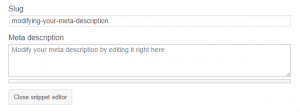SEO Decoded: 6 Simple Steps to Improve Your Rankings
Are you wondering how to improve your site’s rank in search engine results? That question has plagued website owners ever since the days of Lycos and AltaVista.
We don’t claim to hold all the secrets to Search Engine Optimization (SEO), and anyone who says they do is probably trying to sell you something. However, we can introduce you to a few SEO basics you might be overlooking, and that should be enough to provide your site’s search engine performance with a nice boost.
In this article, we’ll cover six simple steps that anyone can put into action to improve their site’s search engine rankings. Let’s start with the simplest.
Step #1: Include Meta Descriptions for Your Pages
Meta descriptions are the brief snippets that appear below the links you see in search engine results. Here’s an example of a meta description, using this blog as the subject:
The point of these descriptions is to tell search engine users what your page is about. The focus should be on conveying the value of the page and convincing visitors to click on it.
Forgoing meta descriptions is a terrible idea – doubly so because adding them is quite simple. Simply use your favorite text editor and add a meta description tag within the head of the document. Here’s an example:
<head>
<meta name="description" content="Your meta description goes here.">
</head>
If you’re a WordPress site user, things are even easier. You can write custom meta descriptions by using a dedicated plugin – such as Yoast SEO or All In One SEO – to add an SEO meta box below the editor of each page or post:
Just type your custom meta description into the appropriate field, and it will be added to your web page markup.
Step #2: Make Good Use of Internal Linking
Internal links marry up the content of one of your posts or pages to related content on the same website. For example, if you’re reading this article, you might also benefit from our guide to basic on-site SEO.
That’s a good example of internal linking because it follows two basic rules:
- It links to relevant content, which is always better than dropping generic links to your homepage. It provides value and makes it easier to find relevant content.
- We used an anchor phrase instead of generic keywords such as click here. That helps search engines determine the subject of the linked page (plus, it just reads better!).
These are great benefits, but that doesn’t mean that you need to go overboard with internal linking. As a rule of thumb, you shouldn’t include internal links just for the sake of including them. Use internal links, but only if they are actually relevant.
Step #3: Name Images Properly and Use Alt Tags
Naming your images using relevant keywords and adding alt tags can improve SEO scores in some cases, and it’s also a good practice from a usability standpoint. Take the following image for example:
If you inserted that image into a blog post, naming it something like red-flower would be preferable to using a random string of letters and numbers. In addition, you should add an ‘alt tag’, also known as alternative text. In this scenario, a good alt tag would be “A photo of a red flower.”
Here’s why filenames and alt text are so important:
- Descriptive file names and proper alt text give search engines an idea of what the image contains, and influences the appearance of the image in image search results.
- Search engines recognize hyphens as word separators, not so with underscores. Use hyphens in your image file names, not underscores.
- Screen readers use alt tags to help visually impaired users navigate the web.
When it comes to alt text, try to include relevant keywords, but write them using natural language in sentence case.
Step #4: Keep Your Permalinks Simple and Meaningful
Let’s talk about permalinks. From an SEO perspective, it’s far better to use descriptive permalinks rather than random strings of letters and numbers.
Take a look at this post’s URL as an example – it’s relatively short, yet it tells you everything you need to know about its content. It’s easy to see why that’s preferable to an automatically generated URL like:
https://www.a2hosting.com/?=2423423
For even better SEO results, you should also consider adhering to these two rules when it comes to permalinks:
- Don’t include stop words. Search engines tend to ignore them, and they can make your URLs too long.
- Try to place important keywords earlier in your permalinks so that search engines will give them more weight.
Step #5: Use Consistent Headings and Subheadings
Making the most of your headings and subheadings is a good practice from both an SEO standpoint and to improve general readability. When it comes to SEO, headings provide search engines with information about the main topics that each page covers. For the best results, you should try to include keywords in headings and subheadings without making them sound forced.
SEO benefits aside, good heading structure also acts as sort of a table of contents. It makes it easier to scan content and breaks it down into natural sections.
On any given page, you should include a single H1 header to denote the title, and stick to H2 and H3 subheadings for the rest of the content. Subheadings go all the way up to H6, but anything beyond H3 suggests you should consider a simpler content structure.
Step #6: Focus on Creating Relevant Content
While the five steps we covered above are crucial to improving the SEO of any website, it’s essential to remember that they are only as effective as the quality of your content. Search engine algorithms get better all the time, and if you create posts or pages that try to game the system, your ranking will suffer as a result.
Instead, focus on creating the best possible content for your readers. Good content will attract backlinks over time, which will help improve your site’s search engine performance organically.
Conclusion
Improving your search engine rankings isn’t an overnight journey. For these steps to succeed, you need to publish high-quality content consistently. If you can do that, you’ll be on the path to higher rankings. Just follow the six steps we’ve mentioned for the best possible results:
- Include meta descriptions for your pages.
- Take advantage of internal linking opportunities.
- Name your images properly and flesh out their alt tags.
- Keep your permalinks short and meaningful.
- Use proper heading and subheading structure.
- Focus on creating good content above all else.
Image credit: StockSnap.io, Pixabay.





![How Fast Hosting & Fast Sites Improve Your Bottom Line [Infographic]](https://www.a2hosting.com/blog/content/uploads/2021/01/web-hosting-performance.jpg)

